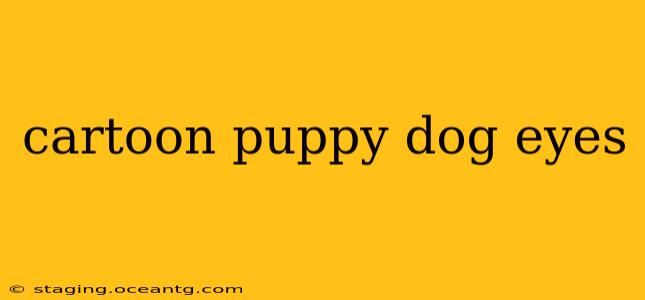Cartoon puppy dog eyes—those large, expressive orbs that melt hearts—are a beloved staple in animation and illustration. But mastering their depiction requires more than just drawing two circles. This guide delves into the techniques and nuances behind creating truly captivating cartoon puppy dog eyes, exploring everything from basic shapes to advanced shading and expression.
What Makes Cartoon Puppy Dog Eyes So Appealing?
The magic of cartoon puppy dog eyes lies in their exaggerated features. Compared to realistic eyes, cartoon versions are significantly larger in proportion to the head, often occupying a significant portion of the face. This disproportionate size, combined with specific stylistic choices, triggers an innate empathetic response in viewers. We instinctively perceive them as innocent, vulnerable, and endearing, instantly evoking feelings of protectiveness and affection.
How to Draw Cartoon Puppy Dog Eyes: A Step-by-Step Guide
Let's break down the process of creating these adorable eyes:
1. Basic Shapes and Proportions:
Start with two large ovals or circles. The size is key—the larger, the more effective the "puppy dog" effect. Consider the overall shape of the head and adjust the eye size accordingly. Placement is also crucial; slightly lower-set eyes often contribute to a cuter, more innocent look.
2. Adding Highlights and Shine:
Highlights are essential for bringing the eyes to life. Place smaller, brighter circles within the larger eye shapes to simulate reflections of light. Experiment with the number and placement of these highlights—a single, strategically placed highlight can create a sense of sparkling energy, while multiple highlights can suggest a more playful or mischievous mood.
3. Defining the Iris and Pupil:
The iris (the colored part of the eye) should be relatively large, and the pupil (the black center) can be smaller than in realistic eyes. Consider varying the iris color—bright, vibrant hues often work best for the "puppy dog" effect. The pupil can be a simple black dot or a slightly larger, more detailed shape.
4. Adding the "Waterline":
This subtle detail adds significant realism. A small, slightly darker line along the lower eyelid mimics the natural waterline of an eye and contributes to the eyes' overall softness.
5. Eyelashes (Optional):
While not strictly necessary, adding long, spiky, or slightly curved eyelashes can greatly enhance the cuteness factor. Keep them simple and avoid overly complex details.
6. Shading and Depth:
Subtle shading can add depth and dimension to the eyes. Adding a slightly darker shade around the edges of the iris or under the lower eyelid creates a three-dimensional effect. Avoid harsh shadows—keep it soft and gentle to maintain the overall cute aesthetic.
Different Styles of Cartoon Puppy Dog Eyes
The "puppy dog eyes" style is highly versatile. Here are a few variations:
- Manga Style: These often feature larger, more expressive eyes with accentuated highlights and a distinctive shine.
- Western Cartoon Style: These can range from simple, round eyes to more detailed and expressive ones, often used in animation and comics.
- Realistic Cartoon Style: Blending realistic elements with cartoon proportions, these eyes maintain a balance between cuteness and believability.
What are some common mistakes when drawing cartoon puppy dog eyes?
Making the eyes too small: The charm of puppy dog eyes comes from their exaggerated size. Don't be afraid to make them large!
Forgetting highlights: Highlights bring the eyes to life. Without them, the eyes will appear flat and lifeless.
Overdoing the shading: While shading adds depth, excessive shading can make the eyes look muddy and less appealing.
Ignoring the proportions of the face: The eyes should be proportional to the rest of the face. Poorly placed eyes can ruin the overall effect.
How do I make my cartoon puppy dog eyes more expressive?
Expression is key! Experiment with the shape of the pupils, the placement of the highlights, and the direction of the gaze to convey a range of emotions. Slightly tilted eyes can suggest playfulness, while wide-open eyes can express surprise or fear.
By mastering these techniques, you can create endearing cartoon puppy dog eyes that will capture hearts and bring your illustrations to life. Remember to practice, experiment, and develop your own unique style!
